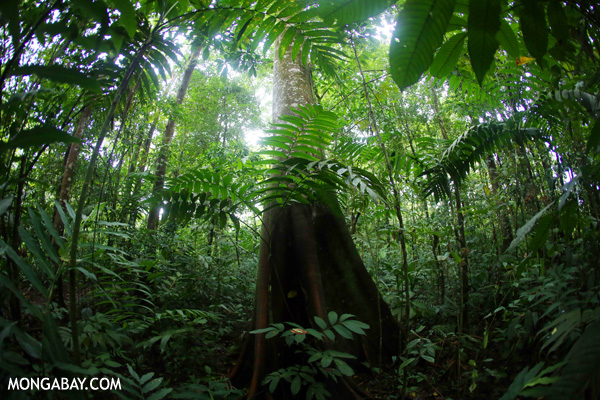Innovation in Tropical Forest Conservation: Q&A with Robin Chazdon
 Rainforest near La Selva, Costa Rica. Photo by Rhett A. Butler.
Rainforest near La Selva, Costa Rica. Photo by Rhett A. Butler.
Dr. Robin Chazdon has dedicated over 30 years to studying and working in tropical forests. Her research interests include biodiversity conservation, regeneration and restoration of tropical forests, and biodiversity in human-modified tropical landscapes.
Currently, Chazdon is a professor at the University of Connecticut in the US, heading a multi-investigator project on long-term secondary forest dynamics in Costa Rica, Mexico, Panama, and Brazil. She is also the director of the recently funded Tropical Reforestation Research Coordination Network (PARTNERS).
Among her laundry list of accomplishments, she has served as Editor-in-Chief of the international journal Biotropica, as President of the Association for Tropical Biology and Conservation, and as a member-at-large of the governing board of the Ecological Society of America. She is an author of over 100 peer-reviewed scientific articles, the co-editor of two books, and the mother of two grown musicians.
In January 2014, she will become the Executive Director of the Association for Tropical Biology and Conservation (ATBC), and her sole-authored book “Second growth: The promise of tropical forest regeneration in an age of deforestation” will be published in May 2014.
An Interview with Dr. Robin Chazdon
Mongabay: What is your background?
 Robin Chazdon. |
Robin Chazdon: I was born and raised in Chicago, Illinois. Went to Grinnell College where I majored in biology. During my second year I spent 6 months in Costa Rica on an off-campus field studies program, which changed my life! After that experience I decided to become a tropical forest ecologist and to dedicate myself to understanding and conserving tropical forests. I got my PhD at Cornell University and returned to the tropics to study the ecology of understory palms at La Selva Biological Station. After three postdocs in the Bay Area, I got a faculty job in the Dept. of Ecology and Evolutionary Biology at the University of Connecticut, where I have been teaching and mentoring students since 1988 (25 years now). I have taught General Ecology, Methods of Ecology (advanced field-based course), Functional Ecology of Plants, and graduate seminars on Current Topics in Biodiversity. Since 1992 I have been studying forest succession in northeastern Costa Rica, and since 2007 have been coordinating a multi-investigator project to study successional pathways in forests of Costa Rica, Brazil, and Mexico.
Mongabay: How long have you worked in tropical forest conservation and in what geographies? What is the focus of your work?
Robin Chazdon: My work in tropical forest conservation has largely coincided with my research on forest regeneration, beginning about 20 years ago. Witnessing the recovery of forests in areas that were cleared and used for pasture and agriculture has made me realize the potential for incorporating regenerating forests into regional conservation programs. So, rather than seeing these forests as degraded counterparts to “primary” forests, they can be viewed as young forests with great potential to protect biodiversity and provide ecosystem services, if nurtured properly and if protected. This work has also incorporated a social perspective, as forests and their status are linked to human activities in surrounding landscapes that are driven by economic, political, and cultural factors at different geographic scales.
Mongabay: What do you see at the next big idea or emerging innovation in tropical forest conservation? And why?
Robin Chazdon: The next big idea is to integrate the social and natural components of forest conservation, use of forest products, and restoration. In reality, these aspects are completely intertwined, but in practice they are completely separated. I believe (along with many others) that the scale at which we can begin to integrate these components is at the landscape scale. Working at the landscape scale will require new approaches and new institutions, and this is where the innovations are needed. Further, the structures that are effective in one region or landscape may not be universally effective. So we need to work with local and regional teams of partners to make forest conservation and restoration work in ways that improve the livelihoods of local people. The traditional “top-down” approach to conservation involving large international conservation organizations that protect forests by isolating them from local people has not prevented massive deforestation around the world; a new approach involving local people as conservation stewards, reforesters, and prudent forest users is required. This is a huge challenge, but it is where we need to go.

Crown of a giant rainforest tree in Costa Rica. Photo by Rhett A. Butler.
Mongabay: Are you currently involved in any projects or research that represent emerging innovation in tropical forest conservation?
Robin Chazdon: I’m so glad you asked! I am directing a new project that will integrate social and ecological aspects of reforestation in the tropics through interdisciplinary synthesis of existing information. This Research Coordination Network was recently funded by the US National Science Foundation, and we called it PARTNERS (People and Reforestation in the Tropics: A Network for Education, Research, and Synthesis). Our goal is to address the social and ecological factors that lead to forest transitions in different tropical regions, the factors that underlie forest resilience, interactions between climate change and reforestation, and the socio-economic and ecological costs and benefits of different reforestation outcomes (natural regeneration, agroforestry, restoration plantations, commercial plantations). PARTNERS will synthesize existing knowledge, identify knowledge gaps, identify new directions for interdisciplinary research, and prepare peer-reviewed documents for educators and policy makers. For more information about the 5-year project, visit our website http://partners-rcn.uconn.edu.
Related articles